Abstract
Serum oxalate rises in uremia because of decreased renal clearance, and crystals of calcium oxalate occur in the tissues of uremic patients. Crystal formation suggests that either uremic serum is supersaturated with calcium oxalate, or local oxalate production or accumulation causes regional supersaturation. To test the first alternative, we ultrafiltered uremic serum and measured supersaturation with two different methods previously used to study supersaturation in urine. First, the relative saturation ratio (RSR), the ratio of the dissolved calcium oxalate complex to the thermodynamic calcium oxalate solubility product, was estimated for 11 uremic (before and after dialysis) and 4 normal serum samples using a computer program. Mean ultrafiltrate oxalate predialysis was 89 +/- 8 microM/liter (+/- SEM), 31 +/- 4 postdialysis, and 10 +/- 3 in normals. Mean RSR was 1.7 +/- 0.1 (predialysis), 0.7 +/- 0.1 (postdialysis), and 0.2 +/- 0.1 (normal), where values greater than 1 denote supersaturation, less than 1, undersaturation. Second, the concentration product ratio (CPR), the ratio of the measured calcium oxalate concentration product before to that after incubation of the sample with calcium oxalate monohydrate crystal, was measured in seven uremic and seven normal serum ultrafiltrates. Mean oxalate was 91 +/- 11 (uremic) and 8 +/- 3 (normal). Mean CPR was 1.4 +/- 0.2 (uremic) and 0.2 +/- 0.1 (normal). Predialysis, 17 of 18 uremic ultrafiltrates were supersaturated with respect to calcium oxalate. The degree of supersaturation was correlated with ultrafiltrate oxalate (RSR, r = 0.99, r = 29, P less than 0.001; CPR, r = 0.75, n = 11, P less than 0.001). A value of ultrafiltrate oxalate of 50 microM/liter separated undersaturated from supersaturated samples and occurred at a creatinine of approximately 9.0 mg/dl.
Full text
PDF
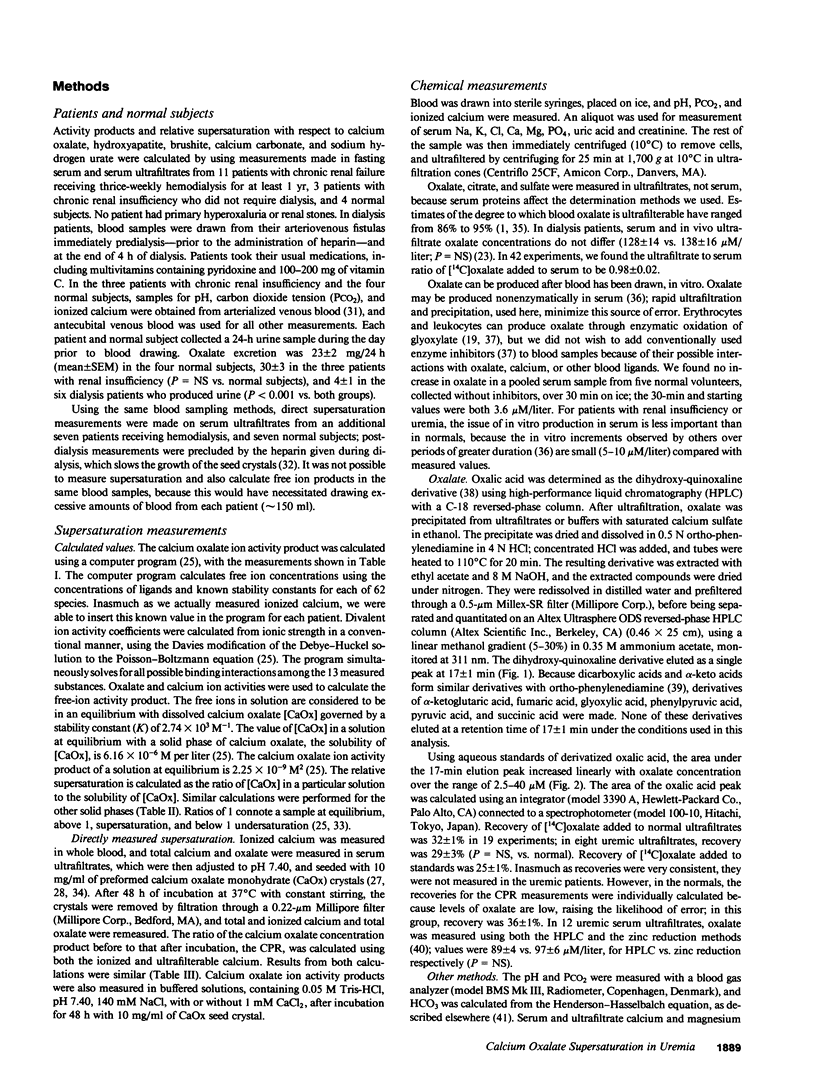
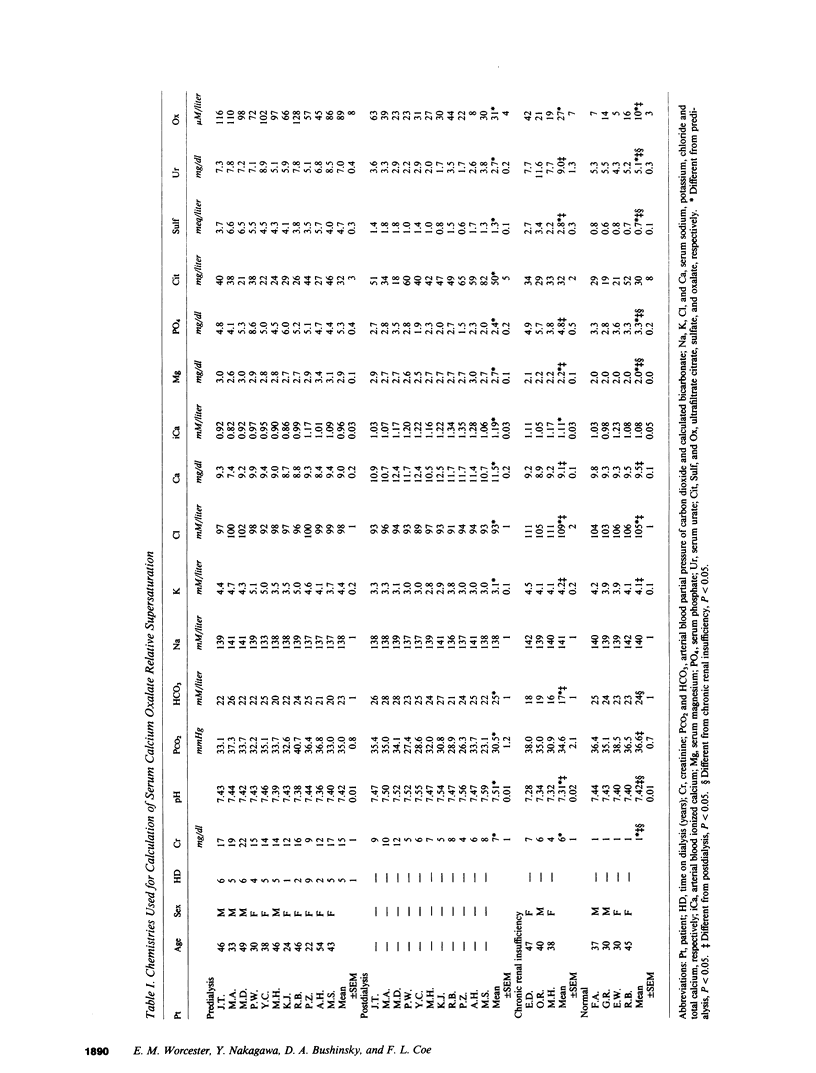
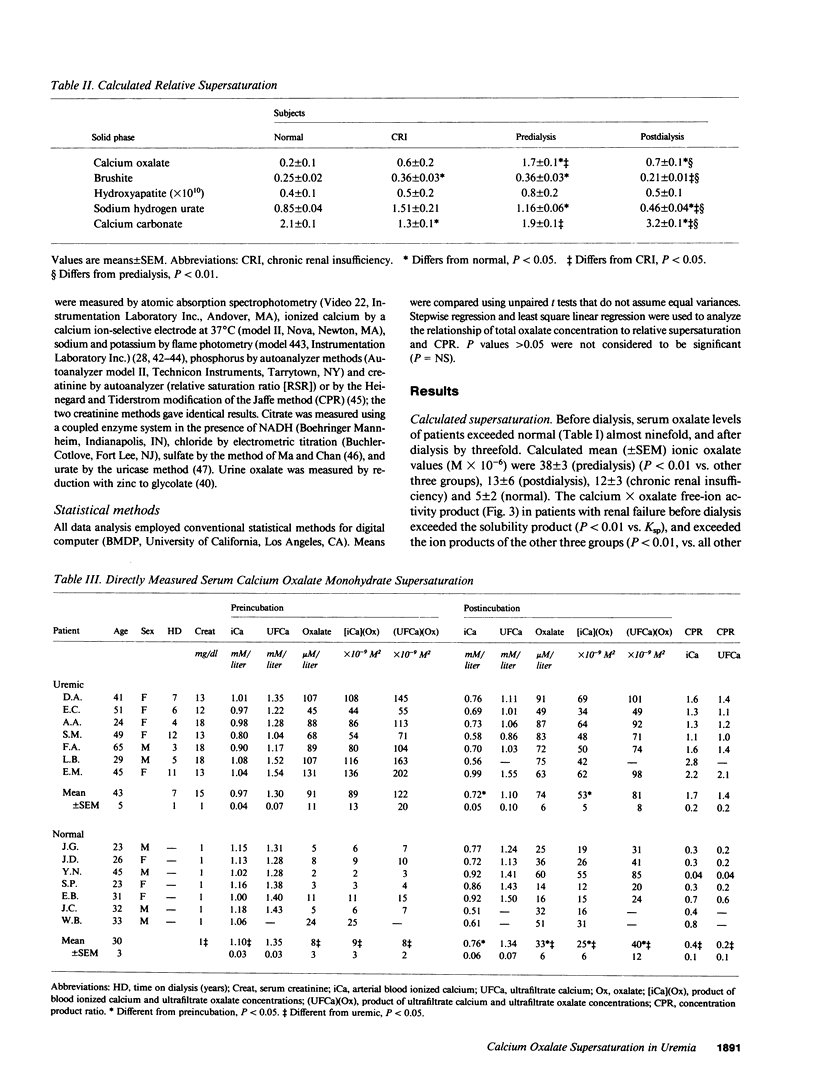
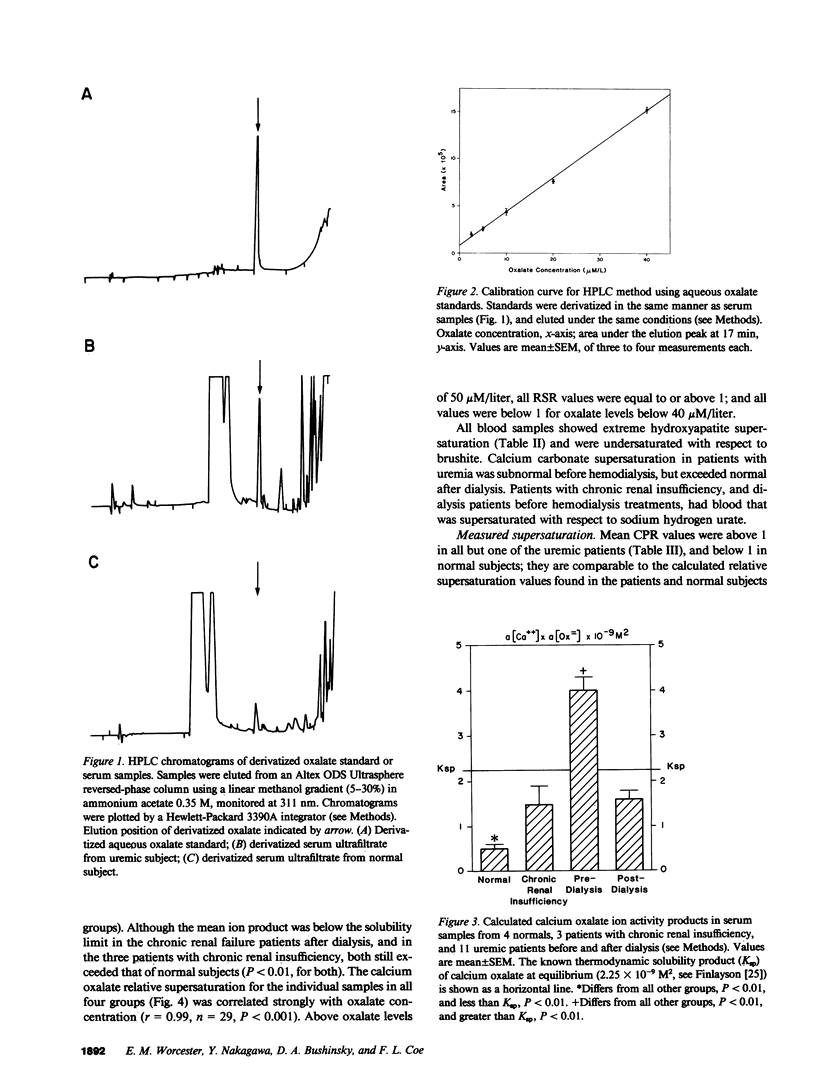
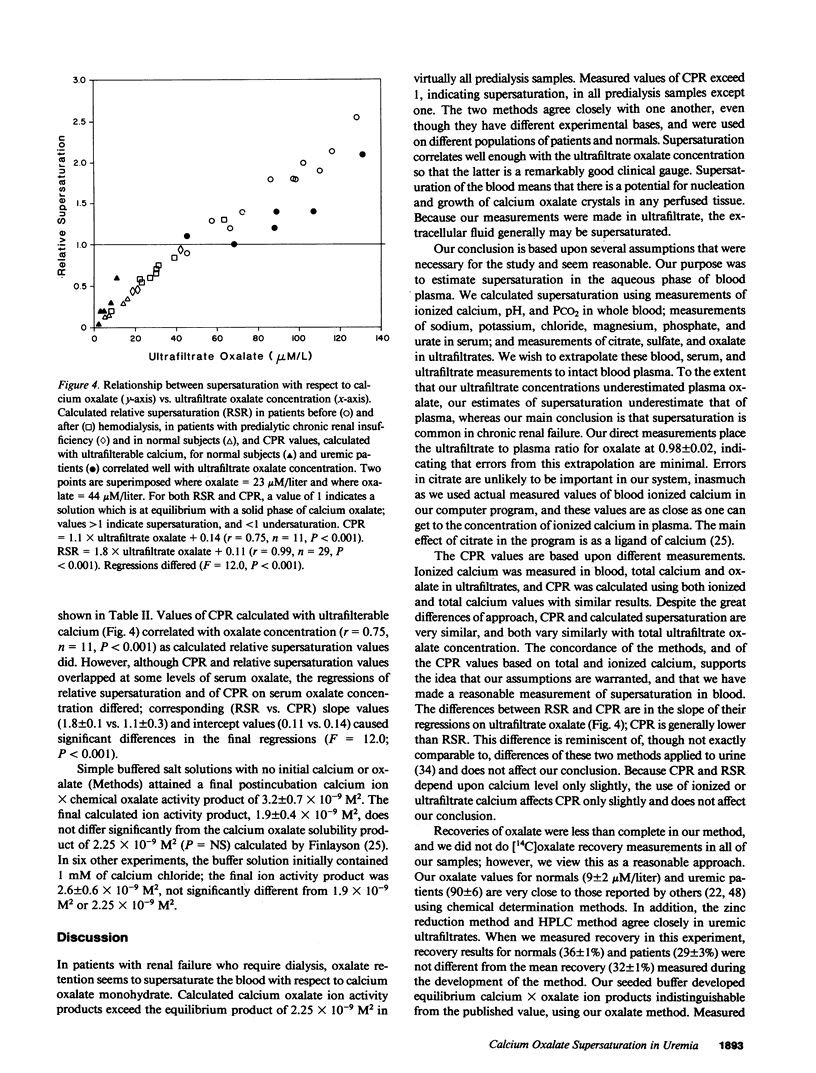
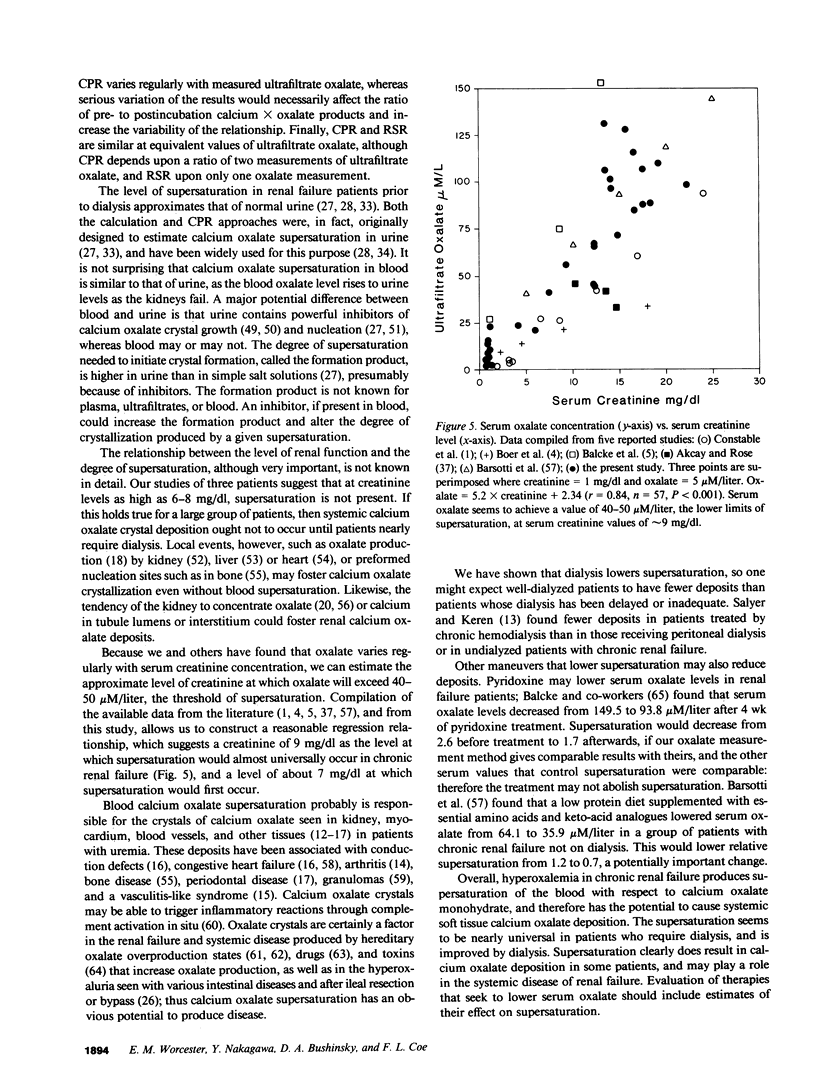

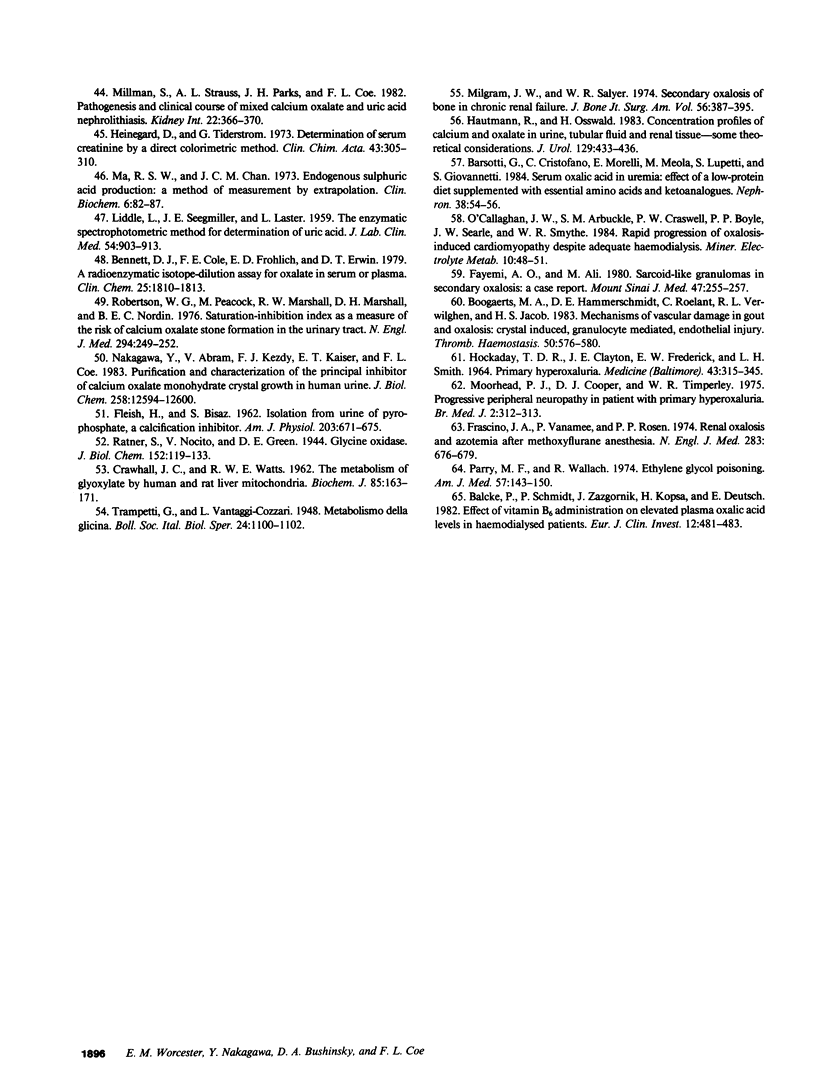
Selected References
These references are in PubMed. This may not be the complete list of references from this article.
- Akcay T., Rose G. A. The real and apparent plasma oxalate. Clin Chim Acta. 1980 Feb 28;101(2-3):305–311. doi: 10.1016/0009-8981(80)90258-2. [DOI] [PubMed] [Google Scholar]
- Balcke P., Schmidt P., Zazgornik J., Haubenstock A., Kopsa H. In vitro synthesis of oxalic acid has no relevant influence on plasma oxalic acid levels in haemodialysis patients. J Clin Chem Clin Biochem. 1984 Mar;22(3):261–263. doi: 10.1515/cclm.1984.22.3.261. [DOI] [PubMed] [Google Scholar]
- Balcke P., Schmidt P., Zazgornik J., Kopsa H., Deutsch E. Effect of vitamin B6 administration on elevated plasma oxalic acid levels in haemodialysed patients. Eur J Clin Invest. 1982 Dec;12(6):481–483. doi: 10.1111/j.1365-2362.1982.tb02229.x. [DOI] [PubMed] [Google Scholar]
- Balcke P., Schmidt P., Zazgornik J., Kopsa H., Deutsch E. Secondary oxalosis in chronic renal insufficiency. N Engl J Med. 1980 Oct 16;303(16):944–944. doi: 10.1056/NEJM198010163031622. [DOI] [PubMed] [Google Scholar]
- Barsotti G., Cristofano C., Morelli E., Meola M., Lupetti S., Giovannetti S. Serum oxalic acid in uremia: effect of a low-protein diet supplemented with essential amino acids and ketoanalogues. Nephron. 1984;38(1):54–56. doi: 10.1159/000183278. [DOI] [PubMed] [Google Scholar]
- Bennett D. J., Cole F. E., Frohlich E. D., Erwin D. T. A radioenzymatic isotope-dilution assay for oxalate in serum or plasma. Clin Chem. 1979 Oct;25(10):1810–1813. [PubMed] [Google Scholar]
- Boer P., van Leersum L., Hené R. J., Mees E. J. Plasma oxalate concentration in chronic renal disease. Am J Kidney Dis. 1984 Sep;4(2):118–122. doi: 10.1016/s0272-6386(84)80058-x. [DOI] [PubMed] [Google Scholar]
- Boogaerts M. A., Hammerschmidt D. E., Roelant C., Verwilghen R. L., Jacob H. S. Mechanisms of vascular damage in gout and oxalosis: crystal induced, granulocyte mediated, endothelial injury. Thromb Haemost. 1983 Aug 30;50(2):576–580. [PubMed] [Google Scholar]
- Bushinsky D. A., Krieger N. S., Geisser D. I., Grossman E. B., Coe F. L. Effects of pH on bone calcium and proton fluxes in vitro. Am J Physiol. 1983 Aug;245(2):F204–F209. doi: 10.1152/ajprenal.1983.245.2.F204. [DOI] [PubMed] [Google Scholar]
- Coburn J. W., Popovtzer M. M., Massry S. G., Kleeman C. R. The physicochemical state and renal handling of divalent ions in chronic renal failure. Arch Intern Med. 1969 Sep;124(3):302–311. [PubMed] [Google Scholar]
- Coe F. L., Firpo J. J., Jr, Hollandsworth D. L., Segil L., Canterbury J. M., Reiss E. Effect of acute and chronic metabolic acidosis on serum immunoreactive parathyroid hormone in man. Kidney Int. 1975 Oct;8(4):263–273. doi: 10.1038/ki.1975.110. [DOI] [PubMed] [Google Scholar]
- Coe F. L., Strauss A. L., Tembe V., Le Dun S. Uric acid saturation in calcium nephrolithiasis. Kidney Int. 1980 May;17(5):662–668. doi: 10.1038/ki.1980.205. [DOI] [PubMed] [Google Scholar]
- Cole F. E., Gladden K. M., Bennett D. J., Erwin D. T. Human plasma oxalate concentration re-examined. Clin Chim Acta. 1984 May 30;139(2):137–143. doi: 10.1016/0009-8981(84)90322-x. [DOI] [PubMed] [Google Scholar]
- Constable A. R., Joekes A. M., Kasidas G. P., O'Regan P., Rose G. A. Plasma level and renal clearance of oxalate in normal subjects and in patients with primary hyperoxaluria or chronic renal failure or both. Clin Sci (Lond) 1979 Apr;56(4):299–304. doi: 10.1042/cs0560299. [DOI] [PubMed] [Google Scholar]
- Contiguglia S. R., Alfrey A. C., Miller N. L., Runnells D. E., Le Geros R. Z. Nature of soft tissue calcification in uremia. Kidney Int. 1973 Sep;4(3):229–235. doi: 10.1038/ki.1973.104. [DOI] [PubMed] [Google Scholar]
- Crawhall J. C., Watts R. W. The metabolism of glyoxylate by human- and rat-liver mitochondria. Biochem J. 1962 Oct;85(1):163–171. doi: 10.1042/bj0850163. [DOI] [PMC free article] [PubMed] [Google Scholar]
- ELDER T. D., WYNGAARDEN J. B. The biosynthesis and turnover of oxalate in normal and hyperoxaluric subjects. J Clin Invest. 1960 Aug;39:1337–1344. doi: 10.1172/JCI104151. [DOI] [PMC free article] [PubMed] [Google Scholar]
- FLEISCH H., BISAZ S. Isolation from urine of pyrophosphate, a calcification inhibitor. Am J Physiol. 1962 Oct;203:671–675. doi: 10.1152/ajplegacy.1962.203.4.671. [DOI] [PubMed] [Google Scholar]
- Fantasia J. E., Miller A. S., Chen S. Y., Foster W. B. Calcium oxalate deposition in the periodontium secondary to chronic renal failure. Oral Surg Oral Med Oral Pathol. 1982 Mar;53(3):273–279. doi: 10.1016/0030-4220(82)90303-6. [DOI] [PubMed] [Google Scholar]
- Fayemi A. O., Ali M., Braun E. V. Oxalosis in hemodialysis patients: a pathologic study of 80 cases. Arch Pathol Lab Med. 1979 Feb;103(2):58–62. [PubMed] [Google Scholar]
- Fayemi A. O., Ali M. Sarcoid-like granulomas in secondary oxalosis: a case report. Mt Sinai J Med. 1980 May-Jun;47(3):255–257. [PubMed] [Google Scholar]
- Forster H. V., Dempsey J. A., Thomson J., Vidruk E., DoPico G. A. Estimation of arterial PO2, PCO2, pH, and lactate from arterialized venous blood. J Appl Physiol. 1972 Jan;32(1):134–137. doi: 10.1152/jappl.1972.32.1.134. [DOI] [PubMed] [Google Scholar]
- Frascino J. A., Vanamee P., Rosen P. P. Renal oxalosis and azotemia after methoxyflurane anesthesia. N Engl J Med. 1970 Sep 24;283(13):676–679. doi: 10.1056/NEJM197009242831304. [DOI] [PubMed] [Google Scholar]
- HOCKADAY T. D., CLAYTON J. E., FREDERICK E. W., SMITH L. H., Jr PRIMARY HYPEROXALURIA. Medicine (Baltimore) 1964 May;43:315–345. doi: 10.1097/00005792-196405000-00010. [DOI] [PubMed] [Google Scholar]
- Hautmann R., Lehmann A., Komor S. Intrarenal distribution of oxalic acid, calcium, sodium, and potassium in man. Eur J Clin Invest. 1980 Apr;10(2 Pt 1):173–176. doi: 10.1111/j.1365-2362.1980.tb02077.x. [DOI] [PubMed] [Google Scholar]
- Hautmann R., Osswald H. Concentration profiles of calcium and oxalate in urine, tubular fluid and renal tissue--some theoretical considerations. J Urol. 1983 Feb;129(2):433–436. doi: 10.1016/s0022-5347(17)52133-3. [DOI] [PubMed] [Google Scholar]
- Hayashi T., Tsuchiya H., Todoriki H., Naruse H. High-performance liquid chromatographic determination of alpha-keto acids in human urine and plasma. Anal Biochem. 1982 May 1;122(1):173–179. doi: 10.1016/0003-2697(82)90267-6. [DOI] [PubMed] [Google Scholar]
- Heinegård D., Tiderström G. Determination of serum creatinine by a direct colorimetric method. Clin Chim Acta. 1973 Feb 12;43(3):305–310. doi: 10.1016/0009-8981(73)90466-x. [DOI] [PubMed] [Google Scholar]
- Hodgkinson A., Wilkinson R. Plasma oxalate concentration and renal excretion of oxalate in man. Clin Sci Mol Med. 1974 Jan;46(1):61–73. doi: 10.1042/cs0460061. [DOI] [PubMed] [Google Scholar]
- Hodgkinson A., Williams A. An improved colorimetric procedure for urine oxalate. Clin Chim Acta. 1972 Jan;36(1):127–132. doi: 10.1016/0009-8981(72)90167-2. [DOI] [PubMed] [Google Scholar]
- Hoffman G. S., Schumacher H. R., Paul H., Cherian V., Reed R., Ramsay A. G., Franck W. A. Calcium oxalate microcrystalline-associated arthritis in end-stage renal disease. Ann Intern Med. 1982 Jul;97(1):36–42. doi: 10.7326/0003-4819-97-1-36. [DOI] [PubMed] [Google Scholar]
- Knight T. F., Sansom S. C., Senekjian H. O., Weinman E. J. Oxalate secretion in the rat proximal tubule. Am J Physiol. 1981 Apr;240(4):F295–F298. doi: 10.1152/ajprenal.1981.240.4.F295. [DOI] [PubMed] [Google Scholar]
- LIDDLE L., SEEGMILLER J. E., LASTER L. The enzymatic spectrophotometric method for determination of uric acid. J Lab Clin Med. 1959 Dec;54:903–913. [PubMed] [Google Scholar]
- Ma R. S., Chan J. C. Endogenous sulphuric acid production: a method of measurement by extrapolation. Clin Biochem. 1973 Jun;6(2):82–87. doi: 10.1016/s0009-9120(73)80016-5. [DOI] [PubMed] [Google Scholar]
- Milgram J. W., Salyer W. R. Secondary oxalosis of bone in chronic renal failure. A histopathological study of three cases. J Bone Joint Surg Am. 1974 Mar;56(2):387–395. [PubMed] [Google Scholar]
- Millman S., Strauss A. L., Parks J. H., Coe F. L. Pathogenesis and clinical course of mixed calcium oxalate and uric acid nephrolithiasis. Kidney Int. 1982 Oct;22(4):366–370. doi: 10.1038/ki.1982.183. [DOI] [PubMed] [Google Scholar]
- Moorhead P. J., Cooper D. J., Timperley W. R. Progressive peripheral neuropathy in patient with primary hyperoxaluria. Br Med J. 1975 May 10;2(5966):312–313. doi: 10.1136/bmj.2.5966.312. [DOI] [PMC free article] [PubMed] [Google Scholar]
- Nakagawa Y., Abram V., Kézdy F. J., Kaiser E. T., Coe F. L. Purification and characterization of the principal inhibitor of calcium oxalate monohydrate crystal growth in human urine. J Biol Chem. 1983 Oct 25;258(20):12594–12600. [PubMed] [Google Scholar]
- O'Callaghan J. W., Arbuckle S. M., Craswell P. W., Boyle P. P., Searle J. W., Smythe W. R. Rapid progression of oxalosis-induced cardiomyopathy despite adequate haemodialysis. Miner Electrolyte Metab. 1984;10(1):48–51. [PubMed] [Google Scholar]
- Pak C. Y., Hayashi Y., Finlayson B., Chu S. Estimation of the state of saturation of brushite and calcium oxalate in urine: a comparison of three methods. J Lab Clin Med. 1977 Apr;89(4):891–901. [PubMed] [Google Scholar]
- Pak C. Y., Holt K. Nucleation and growth of brushite and calcium oxalate in urine of stone-formers. Metabolism. 1976 Jun;25(6):665–673. doi: 10.1016/0026-0495(76)90064-0. [DOI] [PubMed] [Google Scholar]
- Parry M. F., Wallach R. Ethylene glycol poisoning. Am J Med. 1974 Jul;57(1):143–150. doi: 10.1016/0002-9343(74)90780-3. [DOI] [PubMed] [Google Scholar]
- Prenen J. A., Boer P., Dorhout Mees E. J., Endeman H. J., Yoe O. H. Determination of oxalic acid clearance and plasma concentration by radioisotope infusion. Results in a family with hyperoxaluria. Acta Med Scand. 1981;209(1-2):87–91. doi: 10.1111/j.0954-6820.1981.tb11557.x. [DOI] [PubMed] [Google Scholar]
- Ramsay A. G., Reed R. G. Oxalate removal by hemodialysis in end-stage renal disease. Am J Kidney Dis. 1984 Sep;4(2):123–127. doi: 10.1016/s0272-6386(84)80059-1. [DOI] [PubMed] [Google Scholar]
- Robertson W. G., Peacock M., Marshall R. W., Marshall D. H., Nordin B. E. Saturation-inhibition index as a measure of the risk of calcium oxalate stone formation in the urinary tract. N Engl J Med. 1976 Jan 29;294(5):249–252. doi: 10.1056/NEJM197601292940504. [DOI] [PubMed] [Google Scholar]
- Robertson W. G., Peacock M., Nordin B. E. Activity products in stone-forming and non-stone-forming urine. Clin Sci. 1968 Jun;34(3):579–594. [PubMed] [Google Scholar]
- Robertson W. G., Peacock M., Nordin B. E. Inhibitors of the growth and aggregation of calcium oxalate crystals in vitro. Clin Chim Acta. 1973 Jan 10;43(1):31–37. doi: 10.1016/0009-8981(73)90114-9. [DOI] [PubMed] [Google Scholar]
- Salyer W. R., Hutchins G. M. Cardiac lesions in secondary oxalosis. Arch Intern Med. 1974 Aug;134(2):250–252. [PubMed] [Google Scholar]
- Salyer W. R., Keren D. Oxalosis as a complication of chronic renal failure. Kidney Int. 1973 Jul;4(1):61–66. doi: 10.1038/ki.1973.80. [DOI] [PubMed] [Google Scholar]
- Senekjian H. O., Weinman E. J. Oxalate transport by proximal tubule of the rabbit kidney. Am J Physiol. 1982 Sep;243(3):F271–F275. doi: 10.1152/ajprenal.1982.243.3.F271. [DOI] [PubMed] [Google Scholar]
- Smith L. H., Jr, Bauer R. L., Williams H. E. Oxalate and glycolate synthesis by hemic cells. J Lab Clin Med. 1971 Aug;78(2):245–254. [PubMed] [Google Scholar]
- Weber D. V., Coe F. L., Parks J. H., Dunn M. S., Tembe V. Urinary saturation measurements in calcium nephrolithiasis. Ann Intern Med. 1979 Feb;90(2):180–184. doi: 10.7326/0003-4819-90-2-180. [DOI] [PubMed] [Google Scholar]
- Weinman E. J., Frankfurt S. J., Ince A., Sansom S. Renal tubular transport of organic acids. Studies with oxalate and para-aminohippurate in the rat. J Clin Invest. 1978 Mar;61(3):801–806. doi: 10.1172/JCI108994. [DOI] [PMC free article] [PubMed] [Google Scholar]
- Wolthers B. G., Hayer M. The determination of oxalic acid in plasma and urine by means of capillary gas chromatography. Clin Chim Acta. 1982 Mar 26;120(1):87–102. doi: 10.1016/0009-8981(82)90080-8. [DOI] [PubMed] [Google Scholar]
- Zarembski P. M., Hodgkinson A., Parsons F. M. Elevation of the concentration of plasma oxalic acid in renal failure. Nature. 1966 Oct 29;212(5061):511–512. doi: 10.1038/212511a0. [DOI] [PubMed] [Google Scholar]
- Zarembski P. M., Hodgkinson A. The fluorimetric determination of oxalic acid in blood and other biological materials. Biochem J. 1965 Sep;96(3):717–721. doi: 10.1042/bj0960717. [DOI] [PMC free article] [PubMed] [Google Scholar]
- op de Hoek C. T., Diderich P. P., Gratama S., Weijs- von Hofwegen E. J. Oxalosis in chronic renal failure. Proc Eur Dial Transplant Assoc. 1980;17:730–735. [PubMed] [Google Scholar]


